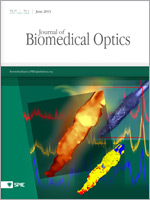New techniques use lasers, LEDs, and optics to ‘see’ under the skin
July 29, 2013

Impressive examples of new non-invasive optical techniques using lasers, light-emitting diodes (LEDs), and spectroscopic methods to probe and render images from beneath the surface of the skin are featured in a newly completed open-access special section in the Journal of Biomedical Optics published by SPIE, the international society for optics and photonics.
The techniques may be used in a wide variety of medical and cosmetic applications such as treating burns, identifying cancer, or speeding the healing of wounds.
“The skin is the biggest organ of the body, and serves as its barrier to the environment,” noted Special Section Guest Editor Jürgen Lademann of the Charité–Universitätsmedizin Berlin. “It provides protection against water loss, keeps micro-organisms from invading the body, and responds sensitively to external stimuli. As a sensory organ, the skin is an essential means of interpersonal communication.”
Because they are easily accessible, the skin barrier and the underlying living cell layers are ideal subjects for investigation by optical and spectroscopic methods using light-based technologies that work from outside the body, Lademann said. Technologies such as fluorescence, reflectance, laser scanning microscopy, and Raman spectroscopy enable identification of tissues and fluids based on how their specific physical and chemical properties cause them to react to different wavelengths of light.
Optical imaging methods are becoming increasingly popular in the field of pharmacology, specifically for investigating the penetration of topically applied substances into and through the skin barrier. Other uses are imaging blood flow and analyzing the wound healing processes.
Ten of the special section’s 31 papers are available via open access in the SPIE Digital Library. Among the open access papers are reports on:
- Non-contact imaging to assess pulse rate, by Yu Sun of Singapore Institute for Neurotechnology and researchers at Loughborough University and Barts and the London School of Medicine and Dentistry
- In vivo imaging to detect skin cancer, by Lioudmila Tchvialeva and others at Vancouver Coastal Health Research Institute, University of British Columbia, BC Cancer Agency, and Simon Fraser University
- Nanoparticle drug delivery through skin, by Leshuai Zhang and Nancy Monteiro-Riviere of Kansas State University
- Non-contact optical assessment of skin burn, by Ryosuke Tanaka and other researchers from several departments at Osaka University and from Nara Medical University and University of Tokushima
- Non-invasive diagnosis of wound healing, by Gitanjal Deka and other researchers at National Yang-Ming University and Taipei City Hospital.
Journal of Biomedical Optics Editor-in-Chief is Lihong Wang, Gene K. Beare Distinguished Professor of Biomedical Engineering at Washington University in St. Louis.
SPIE Digital Library articles are available via subscription or pay-per-view. The SPIE Digital Library contains more than 325,000 articles from SPIE journals, proceedings, and books, with approximately 18,000 new research papers added each year. Abstracts are freely searchable, and a rapidly increasing number of full journal articles are published with open access.
SPIE is the international society for optics and photonics, a not-for-profit organization founded in 1955 to advance light-based technologies. The Society serves more than 235,000 constituents from approximately 155 countries, offering conferences, continuing education, books, journals, and a digital library in support of interdisciplinary information exchange, professional networking, and patent precedent. SPIE provided over $3.2 million in support of education and outreach programs in 2012.